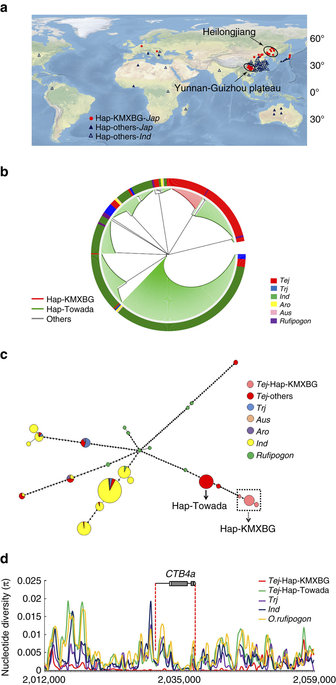

近日,中国农业大学李自超团队在水稻孕穗期耐冷基因克隆与进化研究中取得新进展。他们发现,编码作物中十分保守的蛋白激酶基因CTB4a,能够提高水稻生殖生长期的耐冷性,在低温条件下水稻保持较高花粉育性,从而提高结实率和产量。该研究在《自然通讯》(Nature Communications)上在线全文发表。
李自超课题组与云南农科院合作,利用孕穗期耐冷高原粳稻和冷敏感粳稻为亲本,通过多年杂交和回交构建一系列孕穗期耐冷近等基因系和定位群体,把其中第4号染色体上的耐冷QTL qCTB4-1精细定位在56.8 Kb区间内,结合核苷酸序列分析和表达分析确定CTB4a为候选基因,通过转基因和突变体材料的耐冷性鉴定,最终验证了CTB4a的耐冷功能。
进一步研究发现,亲本启动子变异是引起耐冷性差异的根本原因,单倍型分析发现耐冷单倍型Tej-Hap-KMXBG是温带粳稻在低温环境驯化产生的。此外,研究发现CTB4a与AtpB互作,通过介导冷胁迫下ATP含量调控水稻应对低温胁迫的能力。CTB4a基因的克隆为水稻耐冷理论研究积累经验和数据,也为水稻耐冷育种提供了重要的基因资源。(来源:中国科学报 恩和)
Natural variation in CTB4a enhances rice adaptation to cold habitats
Abstract Low temperature is a major factor limiting rice productivity and geographical distribution. Improved cold tolerance and expanded cultivation to high-altitude or high-latitude regions would help meet growing rice demand. Here we explored a QTL for cold tolerance and cloned the gene, CTB4a (cold tolerance at booting stage), encoding a conserved leucine-rich repeat receptor-like kinase. We show that different CTB4a alleles confer distinct levels of cold tolerance and selection for variation in the CTB4a promoter region has occurred on the basis of environmental temperature. The newly generated cold-tolerant haplotype Tej-Hap-KMXBG was retained by artificial selection during temperate japonica evolution in cold habitats for low-temperature acclimation. Moreover, CTB4a interacts with AtpB, a beta subunit of ATP synthase. Upregulation of CTB4a correlates with increased ATP synthase activity, ATP content, enhanced seed setting and improved yield under cold stress conditions. These findings suggest strategies to improve cold tolerance in crop plants.
原文链接:https://www.nature.com/articles/ncomms14788



